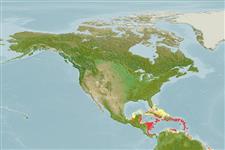Environment: milieu / climate zone / depth range / distribution range
Ecologia
marinhas demersal; intervalo de profundidade 0 - 20 m (Ref. 52855). Tropical
Western Central Atlantic: Haiti to St. Vincent.
Tamanho / Peso / Idade
Maturity: Lm ? range ? - ? cm
Max length : 2.7 cm SL macho/indeterminado; (Ref. 52856)
Espinhos dorsais (total) : 21; Raios dorsais (total) : 7 - 37; Espinhos anais: 2. Common amongst Labrisomids: small, often elongate fishes; largest species about 20 cm SL, most under 10 cm SL. Head usually with cirri or fleshy flaps on anterior nostrils, eyes, and laterally on nape; gill membranes continuous with each other across posteroventral surface of head. Each jaw with an outer row of relatively large, canine-like or incisor-like teeth, often with patches of smaller teeth behind; teeth usually also present on vomer and often on palatines (roof of mouth). Dorsal and anal fins long, frequently highest anteriorly; dorsal-fin spines often flexible, outnumbering segmented dorsal-fin soft rays; 2 usually flexible spines in anal fin; pelvic fins inserted anterior to pectoral-fin bases, with 1 spine not visible externally; all fin rays, including those of caudal, unbranched (simple). Cycloid (smooth to touch) scales present at least posteriorly on body. Species distinguished by: dorsal-fin spines usually 21, and 7 to 37 segmented rays; pelvic fin with 2 externally obvious segmented rays; pectoral-fin rays usually 14; pectoral-fin rays not elongated or filamentous; first anal-fin spine of males longer than second; lateral-line tubes or canals present at least anteriorly on body; scales in lateral-line series usually 35 to 41 (some species with fewer); arched lateral-line scales usually 17 or 18, scales in straight portion of lateral line usually 20 to 22 ; belly naked or with less than posterior third scaled; a simple cirrus present above each eye; cirrus present on anterior nostril; only 1 or no cirrus on each side of nape; . Body coloration: body generally brownish with darker spots, blotches, or broken bars; side of head without spots; broad, unbranched pale area extending from posterior edge of orbit onto preopercle; lips with distinct black vertical bars; pair of broad, hypural-shaped dark blotches not present at base of caudal fin; dark spot, if present at bases of posterior segmented dorsal-fin rays, smaller than 1/2 eye diameter (Ref.52855).
Ciclo de vida ou comportamento de acasalamento
Maturities | Reprodução | Spawnings | Egg(s) | Fecundities | Larvas
Randall, J.E., 1996. Caribbean reef fishes. Third Edition - revised and enlarged. T.F.H. Publications, Inc. Ltd., Hong Kong. 3nd ed. 368 p. (Ref. 13442)
Status na Lista Vermelha da UICN (Ref. 130435)
Ameaça para os humanos
Harmless
Uso pelos humanos
Ferramentas
Relatórios especiais
Baixar XML
Fontes da internet
Estimates based on models
Preferred temperature (Ref.
123201): 27.4 - 28.4, mean 27.8 °C (based on 174 cells).
Índice de diversidade filogenética (Ref.
82804): PD
50 = 0.5000 [Uniqueness, from 0.5 = low to 2.0 = high].
Bayesian length-weight: a=0.00490 (0.00196 - 0.01224), b=3.09 (2.87 - 3.31), in cm total length, based on LWR estimates for this (Sub)family-body shape (Ref.
93245).
Nível Trófico (Ref.
69278): 3.3 ±0.4 se; based on size and trophs of closest relatives
Fishing Vulnerability (Ref.
59153): Low vulnerability (10 of 100).
